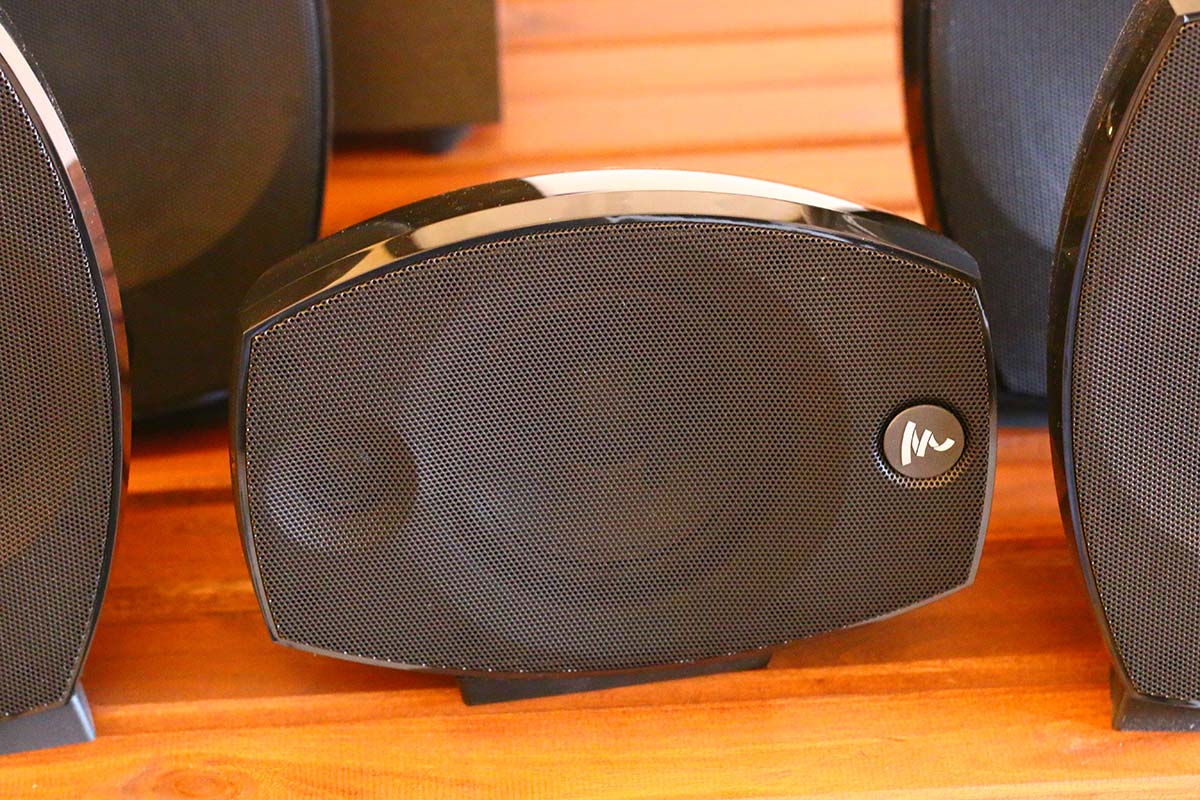
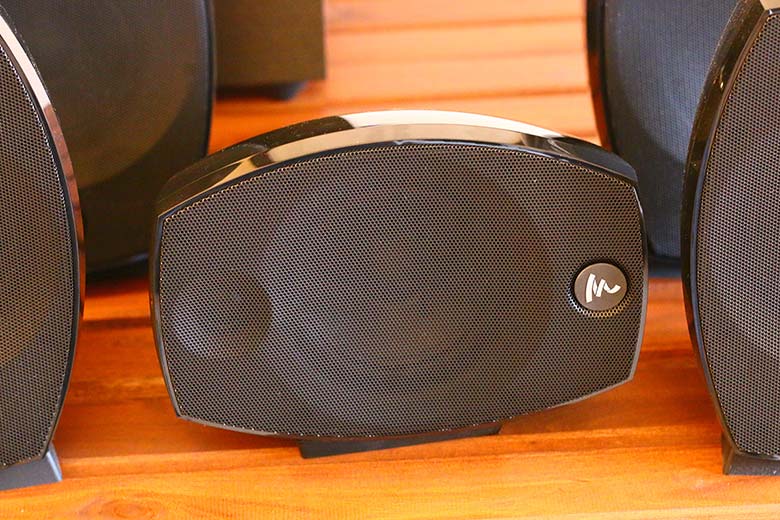
The Master Switch


The Master Switch
5.1-channel surround audio has become the benchmark for home theater sound, offering a far more immersive audio perception than regular two-channel stereo. The format’s popularity has gotten bigger and bigger, and decking out your home entertainment with a 5.1 setup nowadays is easy. If you’re planning to jump on the 5.1 o’clock train, check this out - we’ve rounded up the most exciting home theater systems for this year. And to complete your system, see our list of the best AV receivers.
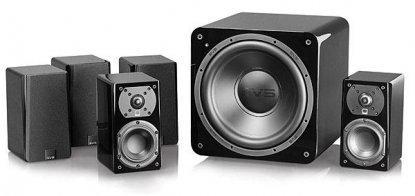 Recommended Amp Power: 20-150W/8Ω
Recommended Amp Power: 20-150W/8Ω
Low Freq: 25Hz
High Freq: 20kHz
What We Like: Reference grade performance, great clarity, lots of features.
What We Don’t: Not as stylish as other speakers.
If you're looking for the right combination of sound quality, clean looks, and functionality, the SVS Prime is our top 5.1 pick for 2023. In small and medium rooms, they just can't be beat, so much so that we've used them to test other speakers against (they are the standard bearer). And how do we know this is the best system for small and medium rooms? Because we have one. As much as we’d love to say The Master Switch bunker was a massive, cavernous Bond lair, it’s actually a compact office, and so we get a good sense of what works in a small space and what doesn’t. So trust us when we say that the SVS Prime Satellite 5.1 System works beautifully. The look of the speakers may be an acquired taste once you remove the grilles, but the clean, compact sound they offer – backed by the amazing SB1000 subwoofer – is absolutely ideal for these types of spaces. All told, you'd be hard pressed to find better sound quality for the money.
These speakers should be powered by a great AV receiver - the Denon AVR-S750H. The forgiving nature of the 750H means that it pairs very well with a wide range of systems. It even offers extra speaker channels, in case you decide to add height speakers at a later date. If you have a small-to-medium-sized room, as most of us do, but still want to experience great sound, then we’d strongly recommend this particular combination.
See the SVS Prime 5.1 Speaker System See the Denon AVR-S750H
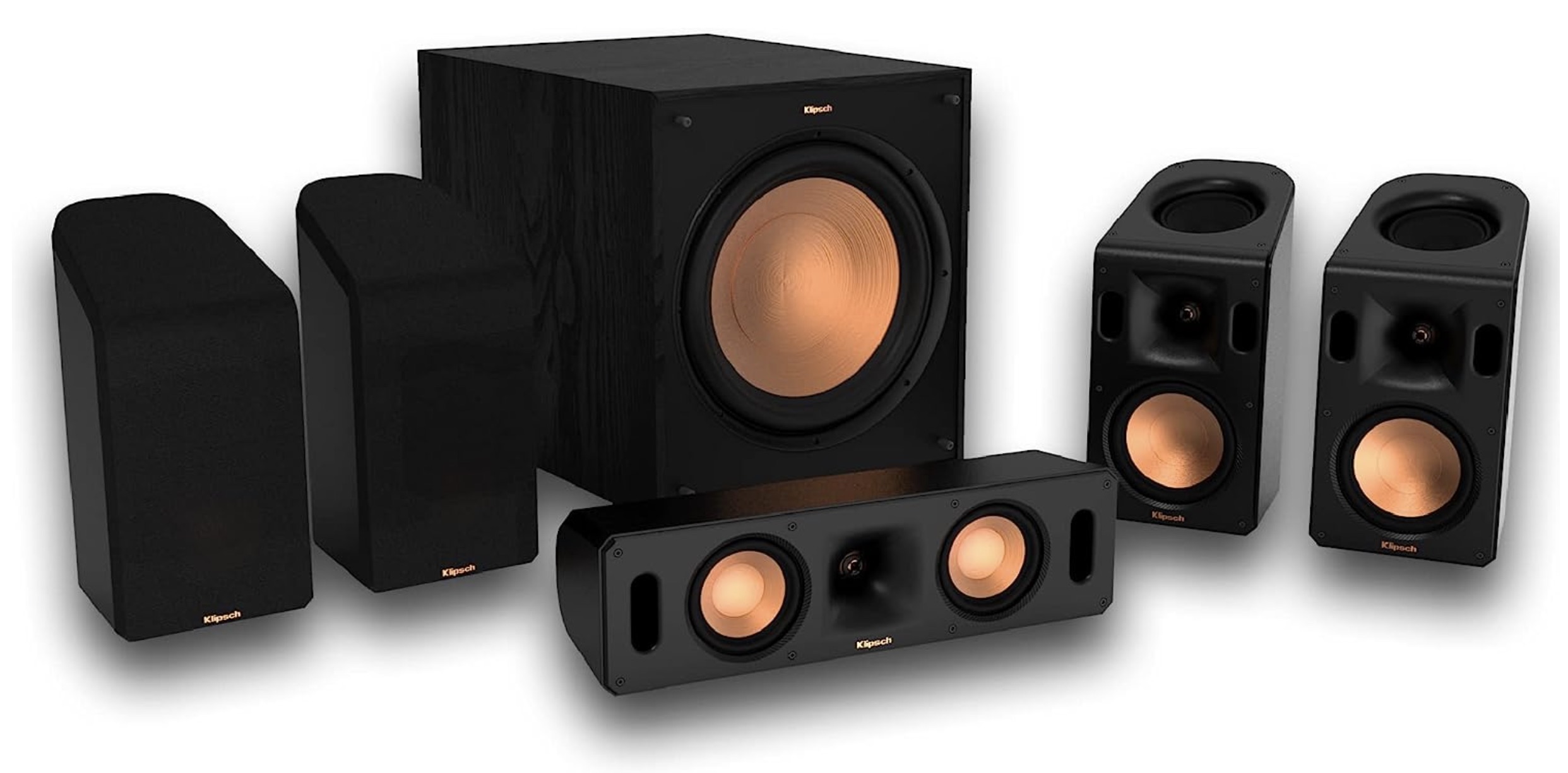 Recommended Amp Power: 20-100W/8Ω
Recommended Amp Power: 20-100W/8Ω
Low Freq: 90Hz
High Freq: 20Hz
What We Like: Excellent sound quality at a good price.
What We Don't: Plastic housing.
Klipsch makes a massive array of home theater speakers and speaker packages. At the budget end of the price range, the Reference 5.14 Dolby Atmos system is an excellent choice. This top seller is a nice alternative to other similarly priced home theater packages on this list. You get five sleek speakers that put out powerful, room-filling sound, as well as a muscular subwoofer. It is the sound, in fact, that puts this home theater package so high on the list. Simply put, speakers this small should not sound this good.
One thing to note is that the Klipsch Black Reference Theater Pack is a bit old-school in its approach. There’s no wireless audio-—check the Vizio soundbar option below for an out-of-the-box package that is both wireless and doesn't require a receiver. In addition, the speakers come in standard plastic housing that doesn’t offer the high-end feel of other options on this list. That said, we love the ease-of-use, sound quality, and value of the Klipsch Reference 5.14 system, which is why it’s our top value pick for 2023.
See the Klipsch Reference See the Denon AVR-S70BT
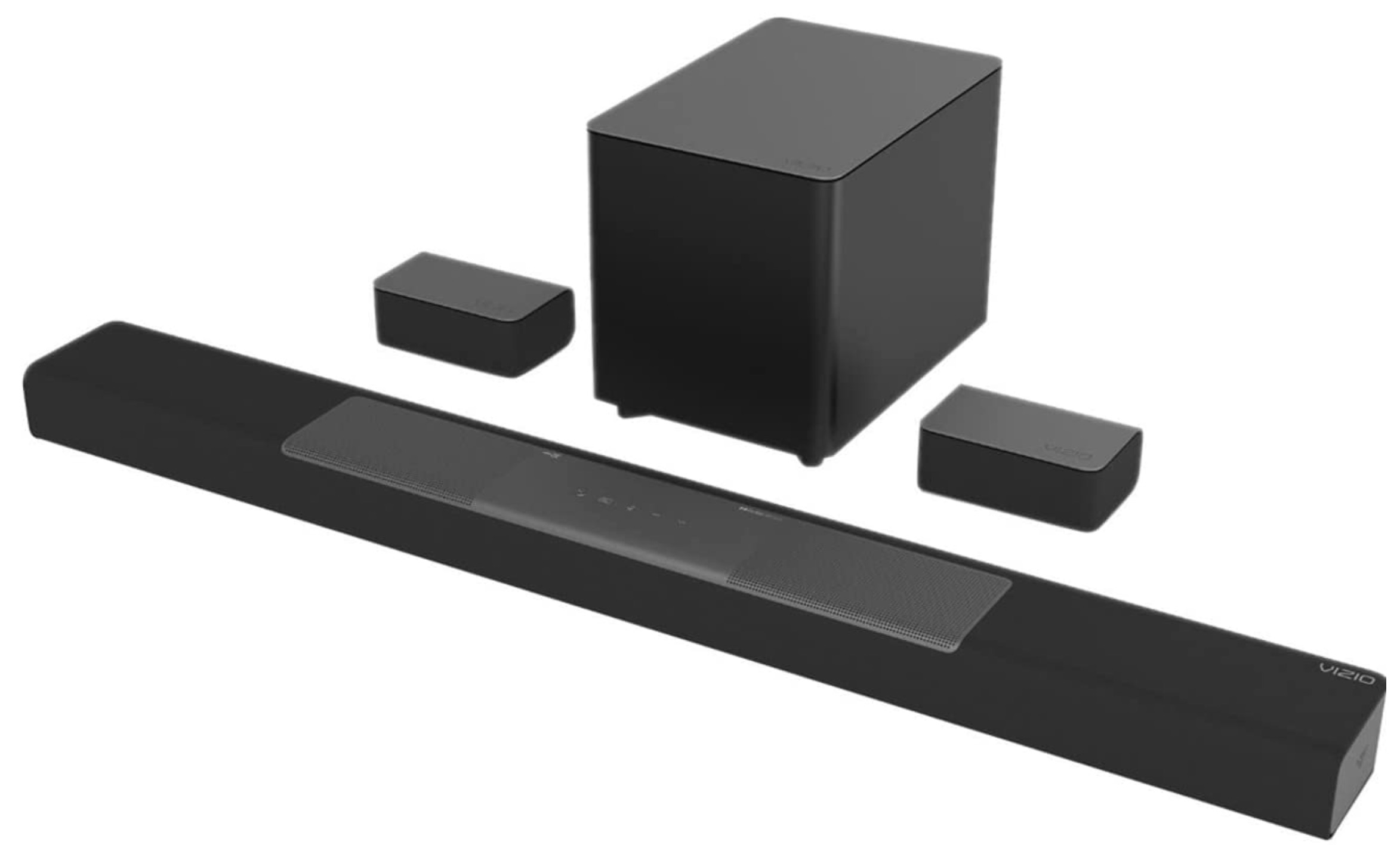 Recommended Amp Power: N/A
Recommended Amp Power: N/A
Low Freq: 45Hz
High Freq: 20kHz
What We Like: Super-simple setup, great sound for a sub-$500 system.
What We Don't: Larger rooms should steer clear.
You’d think the best Dolby Atmos system would be a big, four-figure beast of a system. Not so. In our opinion, the best Dolby Atmos home theater package should offer great Atmos to those of us who don’t have huge rooms or huge budgets. Enter the VIZIO M-Series 5.1.2, a simple soundbar-based package that we think offers stunning Dolby Atmos. Its small footprint, exceptionally simple setup, and killer sound elevate it above the competition. By our reckoning, there are very, very few systems in this price range that offer full Atmos, and we think the M-Series is the only one that belongs on this list. In terms of audio detail, other soundbar-based systems like the Sonos 5.1.2 Surround Set offer more—but that package has no Atmos, and if that’s what you’re after, the VIZIO option is the best one.
If, however, you do have a room over around 250 square feet—a large room, in other words—the VIZIO M-Series 5.1.2 won’t do the job. It just doesn’t have the raw power to fill the space. You’ll need a bigger and more expensive Atmos system, like the Sonos 5.1 Surround Set below. But for many people, the VIZIO soundbar package will be more than capable, able to create very decent height imaging to enhance your movie-watching experience. And for an even higher-quality option in this line, see the Vizio M Series Elevate.
See the VIZIO M Series 5.1.2
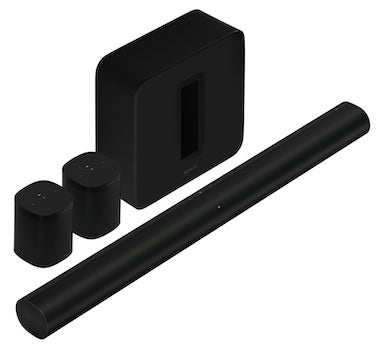 Recommended Amp Power: N/A
Recommended Amp Power: N/A
Low Freq: 25Hz
High Freq: 20kHz
What We Like: Super-convenient wireless sound that is a dream to use.
What We Don’t: Pricey, closed ecosystem.
Sonos have been making major inroads into the world of home theater, which means that other companies should be worried. Hands down, already they own the world of wireless home theatre. This complete system, which packs in a subwoofer, a Dolby Atmos-enabled Arc soundbar, and two satellite speakers, is probably the easiest home theatre package on this list to set up and use. It’s an absolute dream, and while it doesn’t have the depth of something like the ELAC Debut 2.0 5.1, it still sounds terrific.
The most glaring downside of the Sonos 5.1 Surround Set is that it is a closed ecosystem, which means it won’t work with speakers or receivers from other brands. That can be a problem if you want to upgrade later, although you can always add additional Sonos speakers. And if you do want to experience Sonos sound at a more affordable price point, they offer a home theater system with a Beam soundbar, the less expensive alternative to the Arc. That package goes for less but we think it’s an inferior option to this one.
See the Sonos 5.1 Surround Set
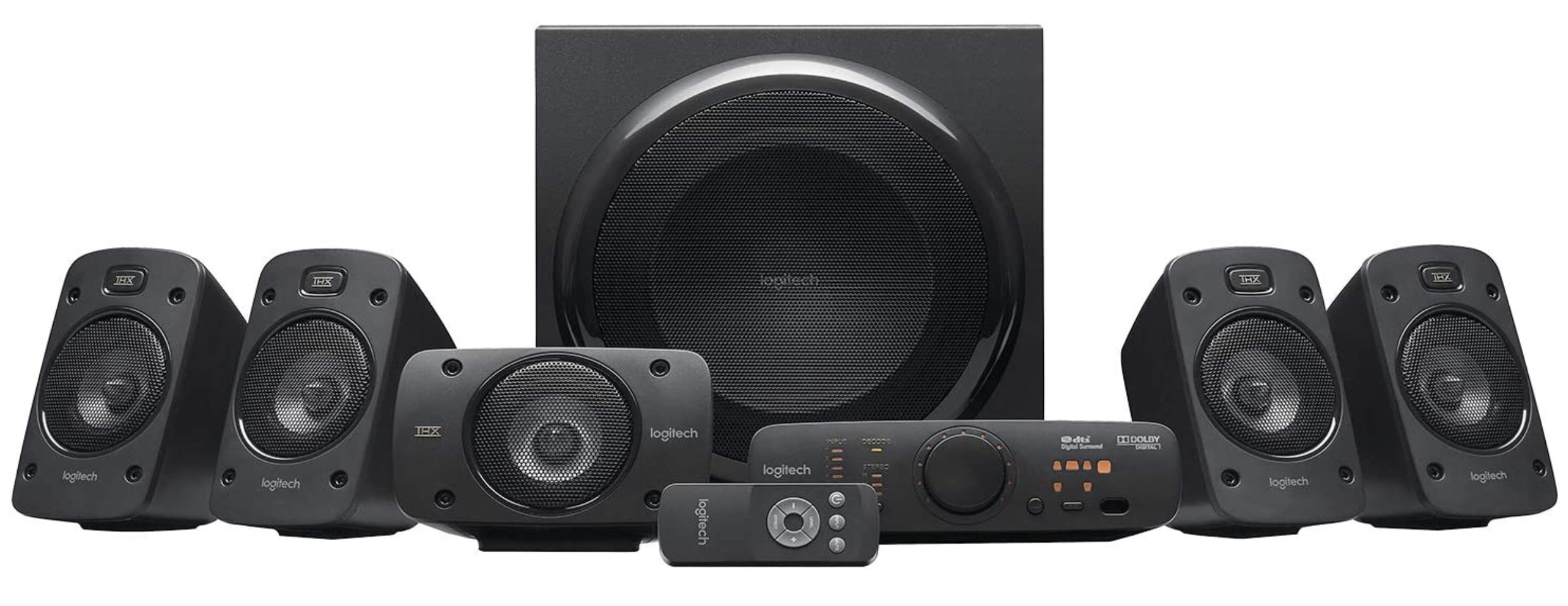 Recommended Amp Power: Unknown
Recommended Amp Power: Unknown
Low Freq: 20Hz
High Freq: 20kHz
What We Like: Fun and funky sound quality, ideal for close-range gaming.
What We Don’t: Issues with dialogue.
If you want surround sound with gaming, you need a system that delivers great audio at close range. The Logitech Z906 fits the bill. It delivers fun and funky sound quality with an emphasis on bass, and does so at an absolutely unbeatable price. It’s the most affordable package on this list and, although it isn’t quite as assured as the Onkyo HT-S3910, it still manages to perform well. A key selling point is that the Logitech Z906 doesn’t require a receiver to work when used with your PC – just connect it to your tower or laptop. You will need a receiver if you use it with your TV, however. We haven’t named a particular receiver here, but we suggest something like the wallet-friendly Pioneer VSX-534.
Despite the Logitech Z906’s appeal, we must say that the sound is far from perfect. These speakers can struggle with dialogue, which can come across as muddy and indistinct at certain volumes. This could be a dealbreaker if you watch lots of movies. If it’s gaming you want, however, this is an affordable and effective way to get the job done. Logitech offer several packages, but we think the Z906 is the best combination of quality and value.
See the Logitech Z906
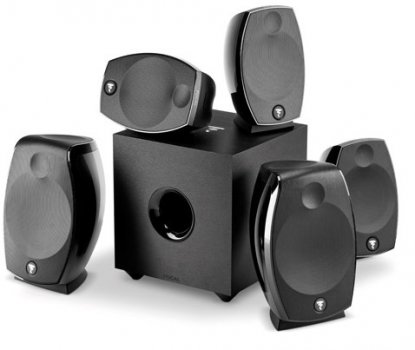 Recommended Amp Power: 25-200W/6Ω
Recommended Amp Power: 25-200W/6Ω
Low Freq: 30Hz
High Freq: 20kHz
What We Like: Industry-standard surround performance, stylish looks.
What We Don’t: Won’t entirely satisfy true Dolby obsessives.
The original Focal Sib Evo speakers immediately elevated themselves to the forefront of home theater audio with their launch back in 2002. The Sib EVO Atmos are their most recently updated version, and Focal have really managed to improve the overall soundstage and bass response of the speakers. As the name suggests, the new Sib Evos have been designed with Dolby Atmos specs in mind. Atmos is all about height information - things happening above your head - and the Sib EVO makes it happen by bouncing sound off the ceiling, using up-firing drivers in the front left and right speakers.Strictly speaking, this may not be a traditional 5.1 setup, as the additional two top-firing channels technically increase the channel count. Dolby aficionados may want to invest in dedicated height speakers, but for the rest of us, these will do just fine.
Denon and Focal have always performed well together, and we think one of the best pairings for the system is the newer AVR-X4700H receiver. It’s stupendously powerful, and has circuitry and features (including Dolby Atmos) that really bring out the best in the SIB EVO. While we will agree that it is more expensive than other receiver options, it’s absolutely worth your time. The speakers here really shine with a good receiver, and we think the Denon is the best option....Read our in-depth review
See the Focal SIB EVO ATMOS 5.1.2 See the Denon AVR-X4700H
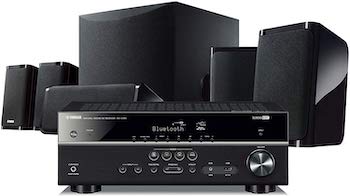 Recommended Amp Power: 70W
Recommended Amp Power: 70W
Low Freq: 20Hz
High Freq: 20kHz
What We Like: Good features and sound quality at a very affordable price.
What We Don't: Sound can distort at high volumes.
Let’s be real: many people just need a home theater system that will get them good surround sound, and they prefer not to pay the earth for it. If that’s you, then we strongly recommend the Yamaha YHT-4950U. It’s a reasonably priced system that has sold by the truckload, and for very good reason. The compact speakers deliver crisp and impressive sound, and particularly excel with movie audio. We also think the additional features push the YHT-4950 over the top. There’s Bluetooth connectivity for music streaming, and Yamaha’s YPAO room calibration to help you get the best quality sound no matter what size or shape your living room is. There’s an AV receiver included too, which means this package contains everything you need to get started.
What do you lose out on? At high volumes, the YHT-4950U tended to distort a little. If you’re the kind of person who likes blasting sound at top volume, you may want to look elsewhere. And as a general rule, the sound here is good rather than spectacular. It’s also true that the YHT-4950U is getting a little long in the tooth now, but a home theater system this good doesn’t go out of style. We’d much rather recommend something affordable than try to push the newest and most expensive gear on you. Great home theater shouldn’t always come at a high price, and we think the YHT-4950U delivers.
See the Yamaha YHT-4950U
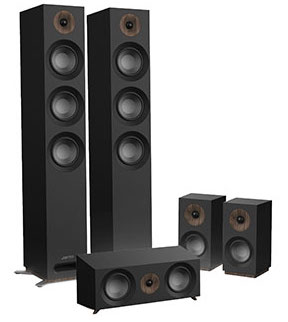 Recommended Amp Power: 120W/8Ω
Recommended Amp Power: 120W/8Ω
Low Freq: 37Hz
High Freq: 26kHz
What We Like: Great sound, Atmos expansion possibilities
What We Don't: No subwoofer? Really?
Jamo is a relatively low-key brand, not very well known outside the home theater space. But they make some fantastic stuff, including their flagship S-809 HCS system. It delivers extraordinary audio quality, very comparable to the top-ranked ELAC Debut 2.0 5.1. It also has some innovative features – the company make Dolby Atmos speakers, and there are slots on the floorstanders in the S-809 system to slot these into, making it easy to expand later. One thing we don't understand: despite the fact that the company makes subwoofers, they do not offer home theater packages that include them. We don't think that's reason enough to exclude a package this good from the list, but it's still a bizarre choice.
To get the best out of this system, you need to go for a workhorse audio receiver that prioritises power and energy over flashy features. We can’t think of a better choice than the Pioneer VSX-935, which delivers 135 watts of power and really seems to bring the best out of the Jamo speakers. An alternative would be the hugely popular Sony STR-DN1080, but it’s more expensive and the Pioneer does a better job here. It also offers additional channels and Sonos functionality, making it relatively future proof. The Jamo/Pioneer combination isn’t the best option here, but it's still worth considering.
See the Jamo S-809 HCS See the Pioneer VSX-935
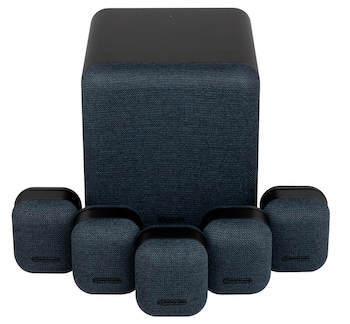 Recommended Amp Power: 25-100W/8Ω
Recommended Amp Power: 25-100W/8Ω
Low Freq: 35Hz
High Freq: 34kHz
What We Like: A solid upgrade on an already-great package.
What We Don’t: Still quite expensive for what you get.
New drivers, new crossovers, and smaller cabinets - Monitor Audio went back to the drawing board with a complete redesign of their MASS system. The result is superb and a clear upgrade on the original. They’ve even reduced the price by a couple of hundred dollars. As with the previous generation, the MASS system is among the most musical here, with excellent tone and clarity. It also works superbly well with movies and series, as one might expect.
This model is forgiving enough to pair well with a variety of receivers, but we think the wallet-friendly Sony STR-DH590 is the best match. It may be a bit old now - Sony have released several newer models - but it’s delivered the best result we’ve heard. Compared to some pricier combos, like the KEF T305 above, this particular combination really delivers. Monitor Audio may not be the most well-known home theater company around, but we think they deserve to be recognized.
See the Monitor Audio MASS Surround Sound See the Sony STR-DH590
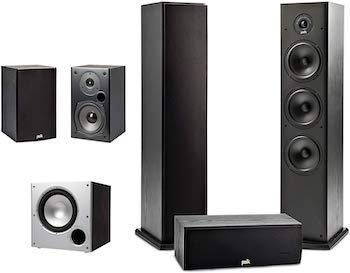 Recommended Amp Power: 100W/8Ω
Recommended Amp Power: 100W/8Ω
Low Freq: Unknown
High Freq: Unknown
What We Like: Hugely customizable package.
What We Don't: Sound can be a little hit-and-miss.
Most of the packages on this list are standard 5.1 – as in, five surround speakers and a subwoofer. But what if you need fewer speakers than that, or you already have a subwoofer? In that case, we’d recommend checking out the Polk Audio 5.1 Bundle. The advantage of this package is it lets you pick exactly the number of speakers and components you need. Three speakers and a receiver? Not a problem. Five speakers and no subwoofer? You got it. It helps that the construction and design is solid, and that the price is attractive. The package listed here is the 5.1 version, and it’s easier to spend more or less depending on your needs. This kind of flexibility is something that other packages in this price range, like the Yamaha YHT-4950U, don’t offer.
One of the downsides to the Polk Audio 5.1 Bundle is that as good as the flexibility is, the sound quality doesn’t always match up to other packages on this list. Dialogue, in particular, can often sound a little bit thin. We also aren’t huge fans of the Polk subwoofer, as we think there are better options available. However, a package that lets you customize to your heart's content deserves to be on this list, as it opens up options that other packages don’t. One thing to note: we’ve seen this package’s name fluctuate (it was previously known as the T Series Bundle) so be aware that they may change the name faster than we can update!
See the Polk Audio 5.1 Bundle See the Denon AVR-S750H
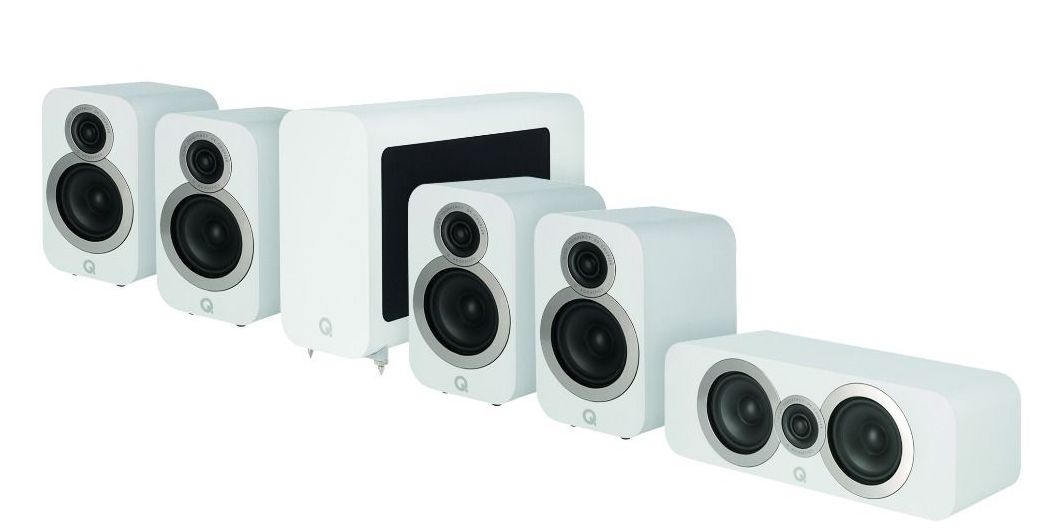 Recommended Amp Power: 50-165W/6Ω
Recommended Amp Power: 50-165W/6Ω
Low Freq: 35Hz
High Freq: 30kHz
What We Like: Excellent spread and detail.
What We Don't: The subwoofer isn't great.
Q Acoustics used to be very difficult to find outside of the USA. That's no longer the case, and with a full American launch, all of the packages and speakers are now available locally. The 3010i Cinema Pack is one of their better offerings: a great value system that delivers superb detail, and which will happily fill up both small and large rooms. We aren't particularly enamored with the subwoofer – the one that comes with the SVS Prime system, above, is much better, and at a cheaper price. But this is still an excellent setup.
In picking the receiver, we opted to go with the versatile and powerful Denon AVR-S960H, new for this year. For the price, you get a staggering range of features – not just Dolby Atmos and DTS:X surround sound, but also 8K picture (although there’s not much content at the moment to support it). 8K aside, we picked this receiver because when combined with the Q Acoustics speakers, it sounds terrific. If you want a more affordable option, we recommend the Sony STR-DN1080, which should combine with the Q Acoustics system nicely.
See the Q Acoustics 3010i Cinema Pack See the Denon AVR-S960H
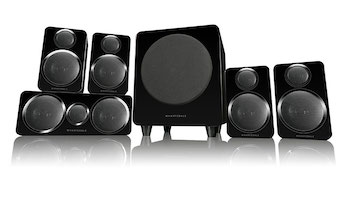 Recommended Amp Power: 30-150W/6Ω
Recommended Amp Power: 30-150W/6Ω
Low Freq: 26Hz
High Freq: 30kHz
What We Like: A compact and cohesive package with solid sound quality.
What We Don't: Other packages offer better value, center speaker isn’t amazing.
We were quite surprised to find that Wharfedale are now offering a full speaker package, but the DX-2 HCP is impressive. Wharfedale have improved the cabinet design on the original DX speaker series, and the DX-2 system not only looks great, but sounds solid as well. Other packages offer better value; particularly the Monoprice speakers, above, and the Onkyo HT-S3910 package. We also found that the center speaker wasn’t quite as good as it could be. That being said, the overall sound is solid, and we think this is an excellent alternative system.
We decided to pair it with the Sony STR-DH590, which is a superb budget receiver. One of the issues we have with this receiver is that the bass can sometimes feel a bit muffled, but when hooked up to the DX-2 HCP, this was far less noticeable. The receiver and speakers work really well together, and if you do end up buying the DX-2 HCP, we highly recommend dropping some cash for the Sony STR-DH590.
See the Wharfedale DX-2 HCP See the Sony STR-DH590
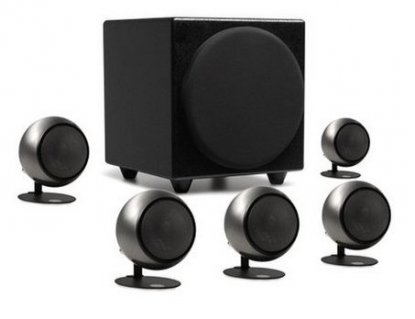 Recommended Amp Power: Unknown
Recommended Amp Power: Unknown
Low Freq: Unknown
High Freq: Unknown
What We Like: Orb Audio has some great design, pairs well with the Onkyo, highly customisable.
What We Don’t: A little too pricey for what you get.
Orb Audio offer quite an unusual system here. To go with their Sub200 subwoofer, you get five of what they call their Orb speakers. These can be mixed and matched in any configuration, and placed just about anywhere. In addition, it’s very easy to upgrade by adding additional Orbs into the mix, although it must be said that we do think the basic system is a little bit too pricey for what you get.
Denon make the best AV receivers in the world— really, we don’t think you can argue differently at this point. The AVR-S960H is the model we’d pick to pair with your brand-new Orb system. It’s an immensely capable machine with a good range of features, and it absolutely makes the little Orb speakers sing. It’s also worth considering options from Marantz, but we’ve found them to be quite expensive in the past, and they don’t really perform better than the capable little Denon receiver.
See the Orb Audio Mod 1 See the Denon AVR-S960H
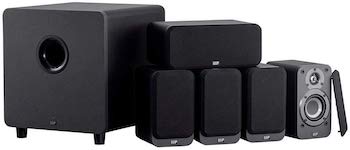 Recommended Amp Power: 20-100W/8Ω
Recommended Amp Power: 20-100W/8Ω
Low Freq: 110Hz
High Freq: 20kHz
What We Like: A basic system with huge value, works well with the Denon receiver.
What We Don't: Sound lacks detail and refinement.
The Monoprice HT-35 is a complete redesign of their old 33309 system, which previously held this position on our list. One of our biggest complaints about that system was the lackluster appearance, so we were very pleased to see that the HT-35 speakers tackled this issue head-on. They look fantastic, and although the sound doesn’t quite have the detail we look for – the Onkyo HT-S3910 beats it here – the HT-35 speakers still deserve a spot on this list.
The Monoprice HT-35 speaker set is quite basic, which means you don’t need to spend much money to power it. Despite not having Dolby or DTS:X, the Denon AVR-S540BT receiver packs a real audio punch. This model feels like it brings the best out of the Monoprice speakers and, for under $400, it comes with an impressive range of features. We do wish that Denon would improve the aesthetic design of their receivers – clearly a problem they share with Monoprice - but boring designs seem to be a trend in the home theater industry.
See the Monoprice HT-35 See the Denon AVR-S540BT
Usually, we’d just have one table, but in this case, we’ve got one for speakers and one for receivers. Speakers are up first:
| System | Price | Rec. Amp Power | Lowest Freq. | Highest Freq. |
|---|---|---|---|---|
| SVS Prime 5.1 | $1,200 | 20-150W/8Ω | 25Hz | 20kHz |
| Klipsch Reference System | $340 | 20-100W/8Ω | 90Hz | 20Hz |
| VIZIO M Series 5.1.2 | $389 | N/A | 45Hz | 20Hz |
| Sonos 5.1 Surround Set | $2,086 | N/A | 25Hz | 20Hz |
| Logitech Z906 | $385 | Unknown | 20Hz | 20Hz |
| Focal SIB EVO ATMOS 5.1.2 | $1,399 | 25-200W/6Ω | 30Hz | 20Hz |
| Yamaha YHT-4950U | $600 | 70W | 20Hz | 20Hz |
| Jamo S-809 HCS | $809 | 120W/8Ω | 37Hz | 26kHz |
| Monitor Audio MASS | $950 | 25-100W/8Ω | 35Hz | 34kHz |
| Polk Audio 5.1 Bundle | $1,023 | 100W/8Ω | Unknown | Unknown |
| Q Acoustics 3010i | $1,142 | 50-165W/6Ω | 35Hz | 30kHz |
| Wharfedale DX-2 HCP | $450 | 30-150W/6Ω | 26Hz | 30kHz |
| Orb Audio Mod 1 | $849 | Unknown | Unknown | Unknown |
| Monoprice HT-35 | $220 | 20-100W/8Ω | 110Hz | 20kHz |
And then the receivers. Inc. means it's included in the speaker package. Note that some receivers appear on our list above more than once, so we've only given them one entry here, in the order in which they appear.
| Receiver | Price | Wattage | Surround Tech. | Conn. |
|---|---|---|---|---|
| Denon AVR-S750H | $819 | 90/8Ω, 2Ch Driven | Dolby Atmos, DTS:X | Blue. / Wi-Fi |
| Denon AVR-S570BT | $340 | 70/8Ω | Dolby TrueHD | Blue. / Wi-Fi |
| Denon AVR-X4700H | $1,600 | 125/8Ω, 2Ch Driven | Dolby Atmos, DTS:X | Blue. / Wi-Fi |
| Pioneer VSX-935 | $445 | 160/8Ω, 2Ch Driven | Dolby Atmos, DTS:X | Blue. / Wi-Fi |
| Sony STR-DH590 | $348 | 145/6Ω, 2Ch Driven | Dolby Digital, DTS-HD | Bluetooth |
| Denon AVR-S750H | $689 | 90/8Ω, 2Ch Driven | Dolby Atmos, DTS:X | Blue. / Wi-Fi |
| Denon AVR-S960H | $479 | 90/8Ω, 2Ch Drive | Dolby Atmos, DTS:X | Blue. / Wi-Fi |
| Sony STR-DN1080 | $802 | Unknown | Dolby Atmos, DTS:X | Blue. / Wi-Fi |
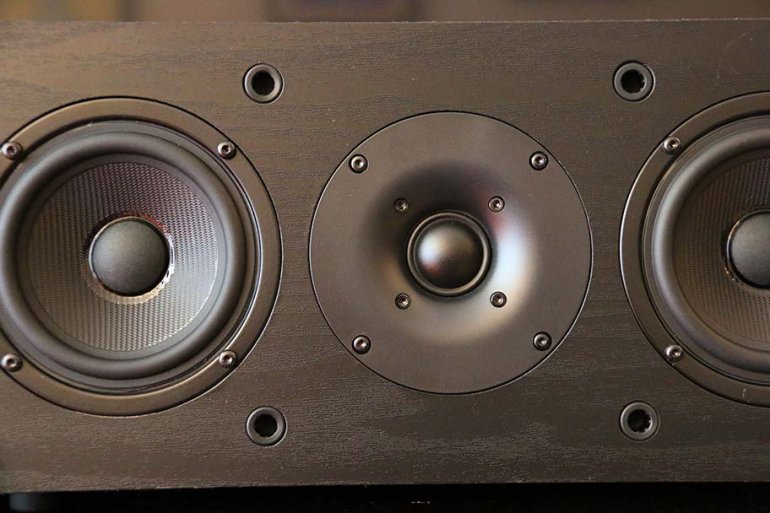
Welcome to the wonderful world of surround sound. Your audio is about to stop coming at you head-on, and come at you from all directions. This type of system consists of five speakers (often called satellite speakers) and a subwoofer, all connected to an AV receiver. The speaker arrangement includes a center channel speaker, left and right front channel speakers, a subwoofer and left and right rear surround speakers. The term 5.1 comes from the fact that there are five speakers, and one subwoofer. This naming convention is standard in home theater, so if we were to tell you about an 11.4 system, you would correctly assume that it consisted of eleven speakers and four subwoofers.
The AV Receiver is linked to a TV (one or more, depending on the receiver's specs) and converts all audio-visual data received from your sources - Blu-Ray/DVD/CD players, Bluetooth, W-Fii etc. into surround sound playback, where sounds can freely "hover" between the surround speakers. In this guide, we're not going to go into what makes a 7.1 or 9.2 system. Those are huge topics in their own right! If you do want to find out more, here's a good breakdown of the differences.
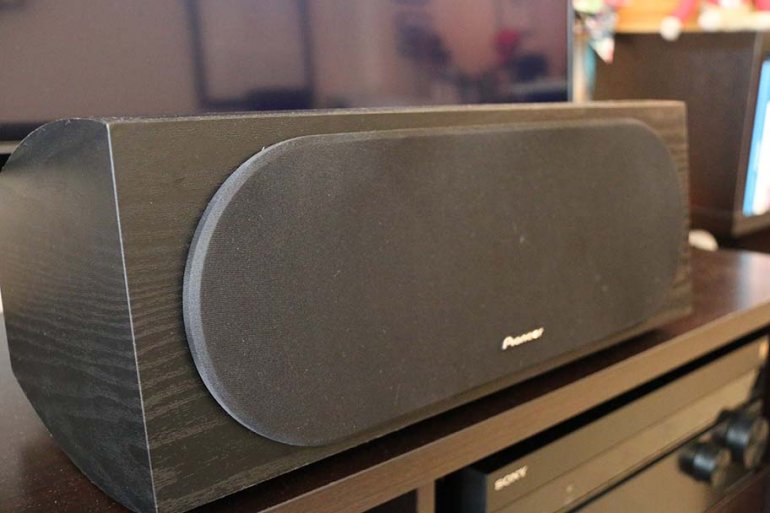
This isn't about just shoving the most expensive speakers and receivers into a list. It's about pairing - about finding the combos that work well together. Obviously, price is an indicator of quality, but we also take into account sound quality, value, build quality and easy-of-use. The brands featured in our quest for pointing you to the best 5.1 surround systems are all well-known, with decades of experience in the field of home theater. We've gone for complete 5.1 speaker systems (as opposed to individual components), and in most cases, we've suggested a great receiver to pair. We've made sure to highlight the best systems and receivers in a few key categories, meaning you should be able to find one that works for you - no matter what your budget. Whether you have $200 or $2,000, we've got something for you.
Serious home theater enthusiasts often created their systems from individual components, matching an AV receiver with a pair of floorstanding speakers, individual satellite speakers, and a carefully chosen subwoofer. The problem is, in the 5.1 range – which is generally considered to be the minimum number of speakers needed for surround sound – there's very little point in doing this. Yes, you will get better sound, but it's often not worth the hassle – not when there are so many excellent packages out there. Hence the rise of something known as Home-Theater-In-A-Box (HTIB): a complete surround sound package, including receiver, that you can buy in one transaction, and which will set you up.
We already mentioned that these have an unfairly maligned reputation, but we think that for many people, they are an ideal solution – and a perfect gateway drug into the joys of surround sound. While not every system on our list is technically an HITB system, in that you will need to buy an additional receiver, we still have a few. Arguably the best on the list is the Axiim 5.1 WM Series Wireless Essential Bundle, Which offers everything you need to get set up in one convenient package. You will however pay just under $3,500 for it, so be warned!
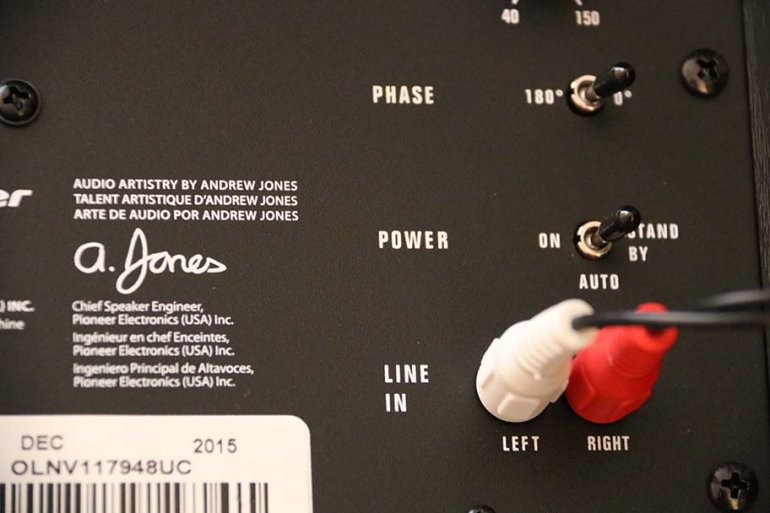
Generally speaking, this is pretty simple. A lot less complicated than bigger systems! Your center speaker goes directly below and in front of your TV. Your front left and front right speakers (which are sometimes floorstanding speakers) go on either side of it. The remaining two satellite speakers go on either side of your listening position, usually bolted to the wall, or on separate speaker stands.
The subwoofer takes a little bit more work. You need to connected up, and place it in your listening position – in other words, on the couch. Then, playing some bass-heavy content, like music, you need to crawl around on the floor, and see where you like the sound of the bass best. That's when you place your subwoofer. Yes, it sounds strange, but this particular manoeuver is known as the subwoofer crawl, and it works. By the way, don't be too stressed about having to lift a heavy subwoofer – most of the ones that come with 5.1 systems are relatively light. The one that ships with the SVS Prime Satellite 5.1 system, for example, weighs only 27lbs.
To experience your system at its best, you might need to fine-tune your setup after some initial listening. Here are a few extra tips. Create a clear path between you and your speakers - if you can't see the speaker, sound is most likely being blocked and the resulting audio performance might be far from its best, due to external acoustic factors and not to the system itself. You can also achieve a far more balanced sound by minimizing bare walls and floors. Having said that, many AV receivers have flexible settings and presets, allowing you to adjust levels - not only between speakers, but also between the volume of movie dialogue or background music and special effects. This can make a huge difference to your viewing experience. If and when available we recommend using the built-in room calibration which normally involves the use of a measurement microphone (supplied with the receiver). You don't need to be an acoustician or a sound engineer - just leaving the mic in the recommended position and pressing a button is all that's needed. The internal acoustic DSP processing measures frequencies and levels from the subwoofer and each satellite speaker and optimizes them to suit your room! By the way, if you're worried about how to connect your receiver, don't be. We've got you covered. Oh, and one more link, which you'll need if you hit any issues: our handy guide to the ten most common home theater problems, and how to solve them. You're welcome.
Any home theater system is going to have, at minimum, two things: a receiver or amplifier, and a set of speakers. Right? (Please say yes. Thank you.) Now obviously, it's the receiver that sends the power to the speakers, and to get the best out of your system, you need to be sending approximately correct levels of power out to the speaker drivers. To do that, we rely on a statistic called RMS wattage.
RMS stands for Root Mean Square. Please don't run screaming. You absolutely do not need to know the mathematics of how this works to understand what it means put simply, RMS wattage. It how much power an amplifier or receiver can put out over an extended period of time. Sometimes, you'll see it referred to as continuous wattage. It's a little bit different from dynamic, or peak wattage. This is the absolute loudest an amp can go, over a short period of time. Think of the differences between RMS and dynamic as being the differences between a marathon and a sprint. Why is this important? Well, every set of speakers has certain power requirements – usually listed as a certain amplifier range (for example, some of the speakers in the ELAC Debut 2.0 5.1 system have a recommended amplifier power of 10-160 watts per channel. That means that, ideally, you need an amplifier where the RMS and dynamic power are both in that range.
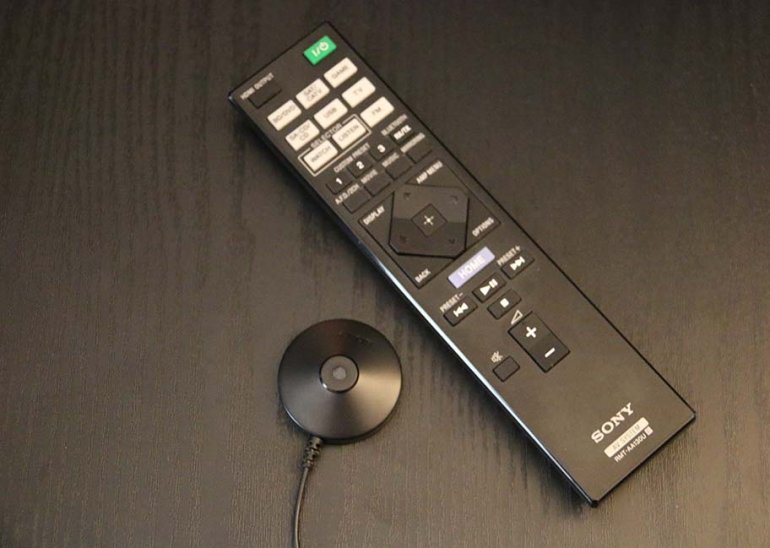
We say ideally because in most cases, you actually don't have to think too hard about matching speakers and amps. Unless you're going to be playing things at ultrahigh volumes for extended periods of time, you'll probably only be delivering a fraction of the amount of power required to damage a speaker. As long as you don't hook up an amp with less RMS power than the minimum required by a speaker (which would be really bad) you'll be fine.
One further point. See that weird symbol (Ω) after our wattage stats in the table above? That's an ohm symbol, and it tells you the amount of power put out at a particular level of electrical resistance. Ideally, you should match these to the speakers. So: if a set of speakers has a recommended amplifier power of 50 watts RMS at an impedance of 8Ω (which you'll sometimes see referred to as nominal impedance), then you need to make sure that your receiver puts out at least that amount of power at 8Ω. Still confused? Don't worry – even we get this wrong sometimes. One of our writers has put together what we consider to be one of the best guides out there to this very topic, which you should really check out. Once you're done, you'll have absolutely no problem matching two systems.
Throughout this article, we often mention somewhat nebulous terms like small rooms and large rooms. We don’t enjoy being nebulous, but we do think the distinction is important. It’s why we’ve highlighted a home theater system that is best for small rooms in the list above (it’s the SVS Prime 5.1 Speaker System in case you’re wondering). You might reasonably ask what constitutes a big room, or a small one.
Here’s the thing. There are no industry guidelines on this. You may as well ask how long a piece of string is! However, we do think that there are some reasonable guidelines you can use to pick a good home theater system, although we do acknowledge that these guidelines are based on our own experiences more than any actual objective measurements. A small room would be any room under around 150 square feet. A medium sized room would be a room of between 150 and 200 square feet, and a large room is anything above 250 square feet.
Again, these are guidelines, and there are many systems that perform perfectly well in small rooms while still delivering huge power. But if you keep these figures in your head when buying, you’ll be able to choose a system that is right for you. That can mean money saved, so it’s worth paying attention to.
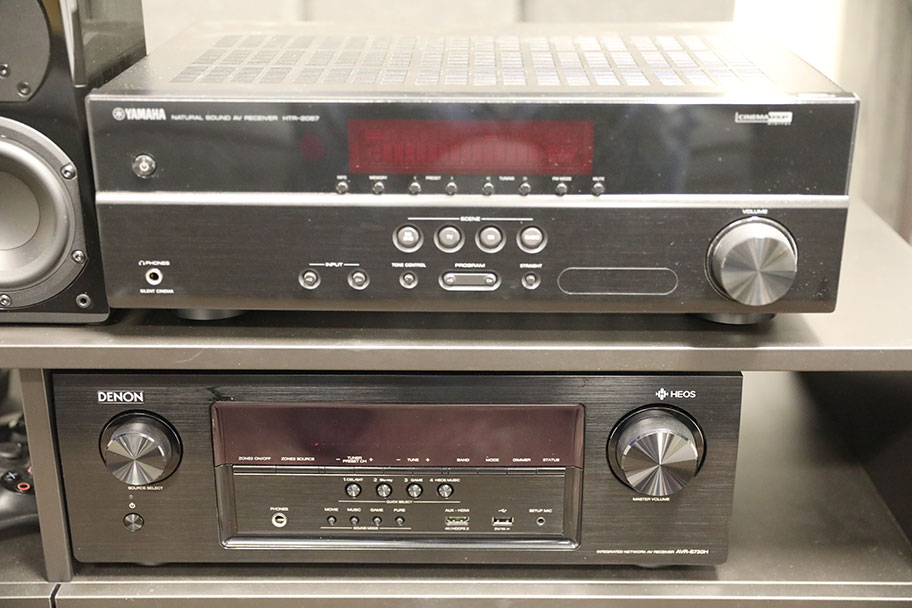
You'll often see these terms thrown around, and we've mentioned them in our receiver specs. They are what are known as surround sound codecs: software programs containing algorithms that mix the incoming sound and distributed evenly between your speakers, creating a certain type of effect. There are two main names in this particular area: Dolby, and DTS. There are significant differences when more speakers are added into the mix – Dolby uses something called object-based surround sound, and relies on height speakers for its industry-standard Atmos codec, while DTS (and its DTS:X codec) is a more user-friendly system that doesn't need height speakers to work. But the key thing to remember is that in the 5.1 arena, there are very few differences between them.
Oh, there may be slight differences depending on the speakers and the receiver in question, but overall, you shouldn't stress too much about this particular element. It's always a plus when you're able to get Dolby or DTS codecs in 5.1, but you are unlikely to be able to take advantage of the latest versions – not unless you upgrade the number of speakers you use! Don't let this deter you, however, from getting started with this particular branch of home theater. You'll have a lot of fun, even if you don't get the latest codec. And by the way, simply because you start with 5.1 doesn't mean you can't upgrade later, and take advantage of things like Dolby Atmos and DTS: X. For example, the Sony STR-DN1080 receiver is capable of utilising both of these.
Another savvy approach, especially for larger home theater rooms is using additional subwoofers - the so called 5.2 or 7.2 setups, where the number after the dot represents the system subwoofer(s). You might think that a regular 5.1 receiver might prevent you using a second subwoofer (due to all outs being already used up), but check at the back of the subwoofer speaker itself, as many of them have a line-level audio output, allowing for direct link to a second woofer. Larger format AV receivers, such as 7.1, 7.2, 9.2 or 11.2 obviously make such extended setups simpler, and despite their higher speaker capacity, 7.2 (or higher) receivers are widely used in regular 5.1 surround setups, where the 'additional' speaker outputs used for separate zones - such as a 2.1 setup in another room for instance.
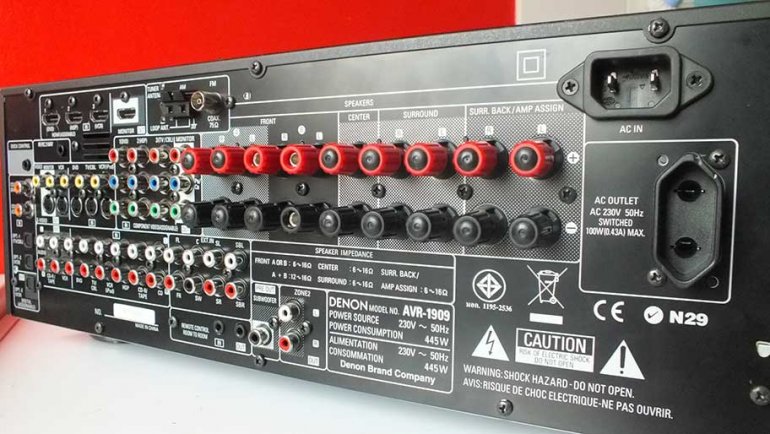
OK, you see the speaker table above? You see how we’ve listed the lowest and highest frequencies a particular system can put out? This is important for a couple of reasons. The first is that it gives you an idea of just how wide the range of of sound your speakers can deliver. Humans can’t really hear anything above 17kHz (kilohertz) so don’t be swayed by a system that can go up to 50kHz, but it’s good to know nonetheless.
One of the things you may have to do at some point is set the subwoofer crossover. Simply put, this is the point in the bass playback at which the subwoofer takes over, meaning that the additional surround speakers don’t have to put out low bass notes. That means more power for the things they are good at. Setting this is absolutely simple. Usually, it’s done via your receiver’s on-screen menu. All you need to do is look at your subwoofer specs, and see the highest frequency it can go. If it’s at, for example, 250Hz, that’s where you set the crossover point. You’ll be amazed at just how much of a difference this can make to your system.
Thank God for HDMI. It’s simple, easy-to-use, high quality, and does pretty much everything you ask of it. HDMI cables carry audio and video signal between different points – such as from your games console to your AV receiver, or from your receiver to your TV. You almost certainly use them before, but if you haven’t, they are the thin connectors with multiple pins shielded by a metal frame. They are robust, and straightforward to use.
They are also the industry standard, and every receiver worth its salt will have at least a few inputs and outputs available to use. Generally, there are far more inputs, as you usually only need to output to your TV, and it’s up to you to figure out just how many you actually need. For the record, the receiver in this list with the greatest choice is the Marantz SR8012, which offers eight HDMI inputs and a staggering three outputs. We’re not even sure what you’d use those for, unless you’re going for an absolutely enormous multiscreen TV system! Still, they are nice to have. And by the way, if you are looking on the back of any of these receivers, and think we’ve got the HDMI input count wrong, check around the front. There is almost certainly an HDMI input on the front panel, and we’ve counted that one as well!
Welcome to one of the more contentious issues in home theater. 4K is a picture standard that is supposed to provide an absolutely stellar viewing experience. While we don’t really deal with visuals here at TMS, it’s worth noting that almost all receivers advertise themselves with their 4K capability, and so we think it’s worth mentioning, even if it’s not something we’re going to spend a great deal of time on.
Essentially, 4K offers a picture resolution of 4,000 pixels, which is absolutely huge. The problem is, while there are plenty of TVs and receivers that take advantage of it, there is not always a lot of content that does the same. 4K movies and series are actually quite rare! It’s likely to become more common over the next few years, but for now, consider this an extra little bit of information to have, and possibly something that you can use to future proof your system. Don’t let it affect the one you buy.
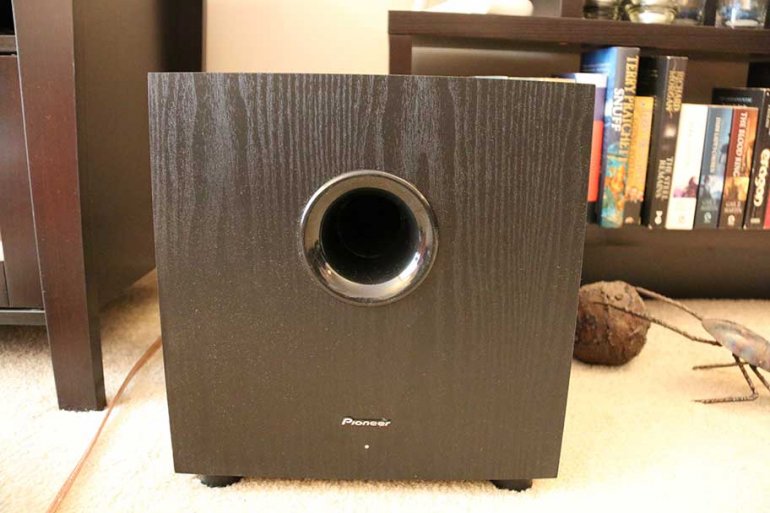
Streaming wirelessly from a smartphone or a tablet to your 5.1 surround sound AV receiver will naturally require you to 'pair' your device with the system exactly as you would with a stereo speaker system. With Wi-Fi capable receivers, you really need to treat those as how you would when integrating a Wi-Fi printer within your home network - any suitable media player can stream via Wi-Fi to your receiver, as long as they are all 'tapped' into your Internet router. As far as audio quality is concerned, Bluetooth is a lossy platform, which means the audio is compressed to save space at the expense of quality, but look out if your system has the aptX-capable Bluetooth streaming. AptX has really grown in popularity in the last year or so, but to coax out its full CD-rivalling audio potential, it is important to make sure that both the source (your smartphone or tablet) and the receiver are compatible with the aptX mode.
You'll notice the presence of a couple of wireless home theater systems on our list: the Axiim 5.1 WM and the Enclave Cinehome 5.1. While these do have disadvantages – chiefly, that you need to plug each speaker into a mains socket to provide power for it, and that their audio quality isn't going to be nearly as good as wired systems – they have significant advantages as well, which you will realise the second you stop having to mess around with speaker cable. They even offer innovations of their own: the Enclave system relies on its own network in a discrete frequency range, taking it off your home Wi-Fi network. Sweet!
There's nothing to say you can't use a conventional 5.1 system for your PC. All you need to do, after all, is connect the receiver to your computer tower, and you're good to go. But there are definite advantages to using specialized systems, like those found in our roundup of the best computer speakers of this year. That's because those are dedicated 5.1 systems design for PC gaming, and although they constitute a bit of a special use-case, they are definitely worth your time.
Firstly, they tend to be smaller, to take into account your closeness to the computer screen, as well as the more compact environments that most PC gaming takes place in. Secondly, they are tuned slightly differently, and more emphasis is given to soundstage. This is so you can accurately determine where in space a particular sound is coming from, making it easier for you to find and murder whatever happens to be shooting at you. Finally, they almost always come as complete packages, with a specialized control unit that offers less functionality than a typical receiver, but which is specifically set up to work with the accompanying speakers. The roundup mentioned above lists several of these packages, but we've put just one in our list: the Logitech Z906. At around $400 at the time of writing, it's an excellent way to boost your PC gaming sound. By the way: if you're a console gamer, then you can quite happily get a 'regular' 5.1 surround sound package. Chances are, you won't be squashed up against the screen, and you'll be in a slightly bigger space!
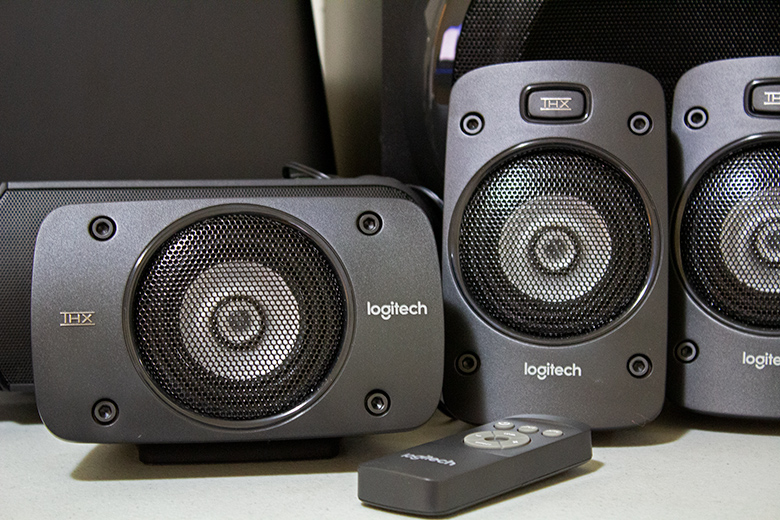
Normally, you wouldn't really see the term WiSA in a discussion of 5.1 home theater. It stands for Wireless Speaker and Audio Association, and is not only an organisation, but also the name of a technology. Put simply, the technology allows different audio components to communicate with each other – similar to Bluetooth, Wi-Fi, or Play-Fi. It's specifically designed to transmit audio with virtually no latency, which is super important if you're watching a movie or series. Why are we only mentioning it now? Because you're going to be hearing a lot more about it in the future. As smart TVs become more entrenched in our lives, they're going to need to send audio directly to speakers. That's where WiSA comes in. It's a proven, existing technology for transmitting audio wirelessly across short distances, and we think it's going to be everywhere this year.
Think about it like this: one of the most annoying things about traditional home theaters is wiring. Having to connect every speaker to a central point is a giant pain. Wireless home theater – and it's worth noting that there are a couple of excellent systems on our list already, like the Axiim 5.1 WM Series – is the next logical step. Sure, you have to plug each speaker into a power outlet, but it's not that big of a deal for most people. Currently, there aren't many existing wireless speaker packages for home theater, because transmitting audio seamlessly to five or more speakers at once is actually pretty tricky. WiSA simplifies the process and works with almost no setup required.
Right now, there are no systems on our list that use WiSA – but they're definitely on the way. The forthcoming Klipsch Reference Wireless system uses WiSA, and we will have many more thoughts on that in due course. In particular, we are looking forward to seeing how the sound quality holds up versus a traditional wired speaker systems.
Back To Our 5.1 Home Theater Picks Back To Our Comparison Tables